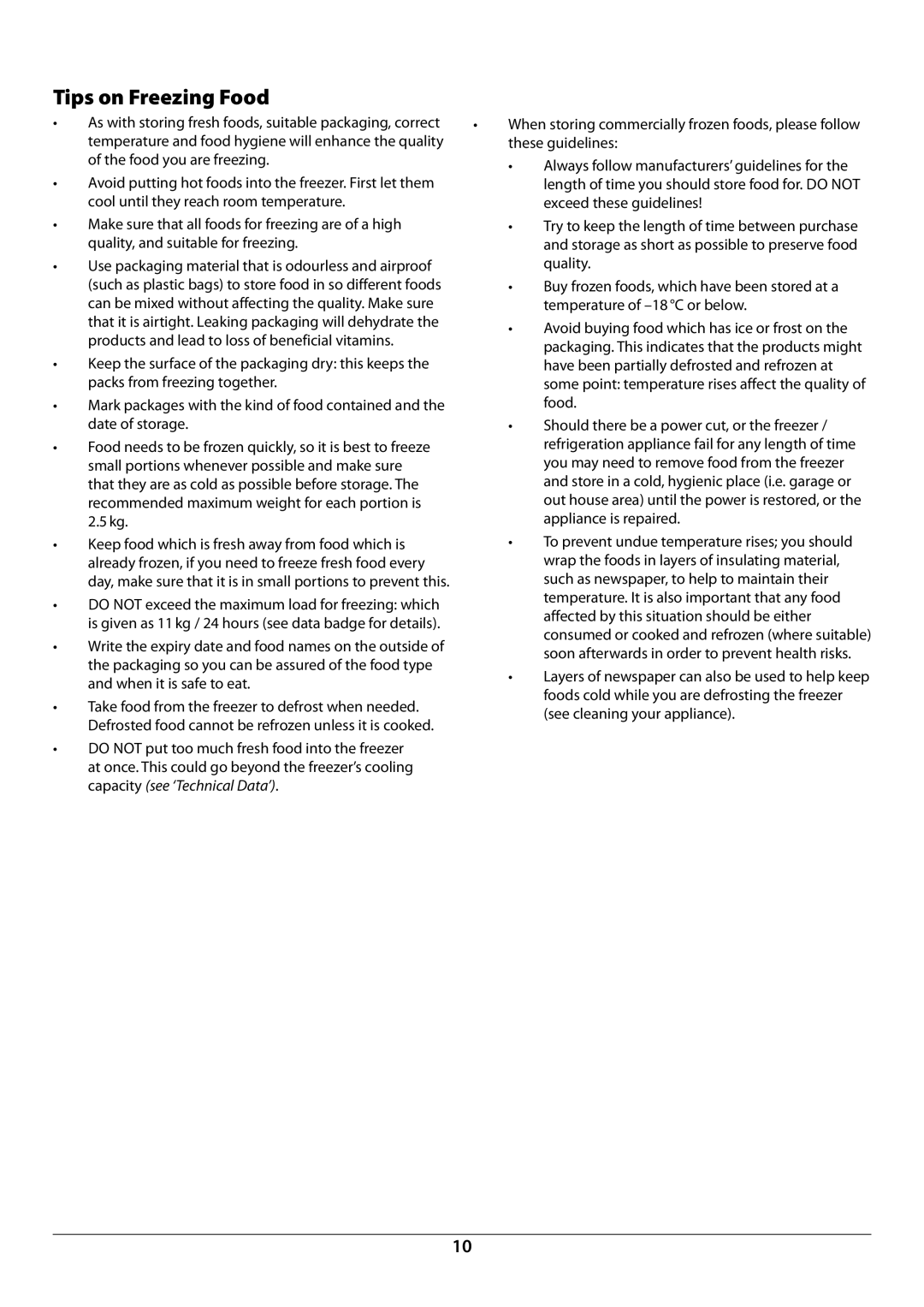Tips on Freezing Food
• | As with storing fresh foods, suitable packaging, correct | • | When storing commercially frozen foods, please follow | |
| temperature and food hygiene will enhance the quality |
| these guidelines: | |
| of the food you are freezing. |
| • | Always follow manufacturers’ guidelines for the |
• | Avoid putting hot foods into the freezer. First let them |
| ||
|
| length of time you should store food for. DO NOT | ||
| cool until they reach room temperature. |
|
| exceed these guidelines! |
• | Make sure that all foods for freezing are of a high |
| • | Try to keep the length of time between purchase |
| quality, and suitable for freezing. |
|
| and storage as short as possible to preserve food |
• | Use packaging material that is odourless and airproof |
|
| quality. |
| (such as plastic bags) to store food in so different foods |
| • | Buy frozen foods, which have been stored at a |
| can be mixed without affecting the quality. Make sure |
|
| temperature of |
| that it is airtight. Leaking packaging will dehydrate the |
| • | Avoid buying food which has ice or frost on the |
| products and lead to loss of beneficial vitamins. |
| ||
|
|
| packaging. This indicates that the products might | |
• | Keep the surface of the packaging dry: this keeps the |
|
| |
|
| have been partially defrosted and refrozen at | ||
| packs from freezing together. |
|
| some point: temperature rises affect the quality of |
• | Mark packages with the kind of food contained and the |
|
| food. |
| date of storage. |
| • | Should there be a power cut, or the freezer / |
• | Food needs to be frozen quickly, so it is best to freeze |
|
| refrigeration appliance fail for any length of time |
| small portions whenever possible and make sure |
|
| you may need to remove food from the freezer |
| that they are as cold as possible before storage. The |
|
| and store in a cold, hygienic place (i.e. garage or |
| recommended maximum weight for each portion is |
|
| out house area) until the power is restored, or the |
| 2.5 kg. |
|
| appliance is repaired. |
• | Keep food which is fresh away from food which is |
| • | To prevent undue temperature rises; you should |
| already frozen, if you need to freeze fresh food every |
|
| wrap the foods in layers of insulating material, |
| day, make sure that it is in small portions to prevent this. |
|
| such as newspaper, to help to maintain their |
• | DO NOT exceed the maximum load for freezing: which |
|
| temperature. It is also important that any food |
|
| affected by this situation should be either | ||
| is given as 11 kg / 24 hours (see data badge for details). |
|
| |
|
|
| consumed or cooked and refrozen (where suitable) | |
• | Write the expiry date and food names on the outside of |
|
| |
|
| soon afterwards in order to prevent health risks. | ||
| the packaging so you can be assured of the food type |
|
| |
|
| • | Layers of newspaper can also be used to help keep | |
| and when it is safe to eat. |
| ||
|
|
| foods cold while you are defrosting the freezer | |
• | Take food from the freezer to defrost when needed. |
|
| |
|
| (see cleaning your appliance). | ||
| Defrosted food cannot be refrozen unless it is cooked. |
|
| |
|
|
|
| |
•DO NOT put too much fresh food into the freezer at once. This could go beyond the freezer’s cooling capacity (see ‘Technical Data’).
10
